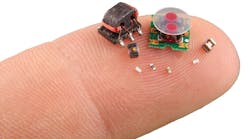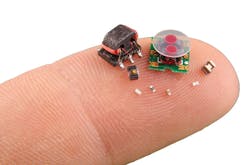The Microsystems Technology Office at DARPA is searching out for innovative proposals that enable revolutionary advances in robotic science, devices, or systems (see figure). Specifically excluded is research that primarily results in evolutionary improvements to the existing state of practice. The requested proposals will cover the following areas:
- Actuator materials and actuator mechanism development
- Integrated multimode power solutions for both storage and high voltage conversion
- Untethered, multifunctional micro-to-milli-robotic platforms
Micro-to-milli (i.e., insect scale) robotic research has benefited tremendously from prior technological advances in microelectromechanical systems (MEMS) and specific technologies for building small robots. But, as yet, there are no complete micro- or milli-robotic systems with the ability to perform complex tasks proficiently. Moreover, the vast majority of micro- and milli robots today rely on tethers (physical, optical, magnetic, or RF) to supply power, control, and processing, which limits their usability in real-world applications.
SHRIMP Olympics
This SHort-Range Independent Microrobotic Platforms (SHRIMP) aims to develop and demonstrate, through a series of Olympic-themed competitions, multifunctional millimeter-to-centimeter scale robotic platforms. To achieve this goal, SHRIMP will also develop fundamental actuator and power components to facilitate advances in these platforms. The objective is to realize short range micro-to-milli-robotic platforms capable of performing complex tasks for disaster and emergency relief activities, as well as inspection of hazardous environments that are inaccessible to larger robotic platforms.
As a guide to drive the innovations in these platforms, aspects of the National Institute of Standards and Technology (NIST) first-responder robotics test facility have been adapted for micro-to-milli robots. The key drivers are mobility, manipulation, improvements of actuator materials and mechanisms, power storage/endurance and conversion circuitry, and platform engineering for extreme size, weight, and power (SWaP) minimization.
“Whether in a natural disaster scenario, a search and rescue mission, a hazardous environment, or other critical relief situation, robots have the potential to provide much needed aide and support,” says Dr. Ronald Polcawich, a DARPA program manager in the Microsystems Technology Office (MTO). “However, there are a number of environments that are inaccessible for larger robotic platforms. Smaller robotics systems could provide significant aid, but shrinking down these platforms requires significant advancement of the underlying technology.”
Technological advances in MEMS, additive manufacturing, piezoelectric actuators, and low-power sensors have allowed researchers to expand into the realm of micro-to-milli robotics. However, due to the technical obstacles experienced as the technology shrinks, these platforms lack the power, navigation, and control to accomplish complex tasks proficiently.
To overcome the challenges of creating extremely SWaP-constrained micro-robotics, SHRIMP will explore fundamental research in actuator materials and mechanisms as well as power storage components, both of which are necessary to create the strength, dexterity, and independence of functional micro-robotics platforms.
Actuator technologies greatly affect a robotic platform’s mobility, load-bearing capacity, and dexterity, among other capabilities. Under the SHRIMP program, researchers will work to push beyond the current state-of-the-art and develop actuator materials and mechanisms that prioritize force generation, efficiency, strength-to-weight ratio, and maximum work density.
The SHRIMP program is intended for the development of multifunctional millimeter-to-centimeter scale robotics for search and rescue, disaster relief, hazardous environment inspection, in-flight control of aerodynamic platforms, steerable optics, and prosthetics. (Credit: DARPA)
“The strength-to-weight ratio of an actuator influences both the load-bearing capability and endurance of a micro-robotic platform, while the maximum work density characterizes the capability of an actuator mechanism to perform high-intensity tasks or operate over a desired duration,” says Polcawich. “Making significant advances to actuator mechanisms and materials will greatly impact our ability to develop micro-to-milli robotic platforms capable of performing complex tasks in the field.”
Micro-to-Milli Power
Besides advancing the state-of-the-art for actuator technology, SHRIMP seeks to develop highly efficient power storage devices and power-conversion circuitry. Most micro-robotics platforms rely on tethers for power, processing, or control, and are significantly constrained by energy-inefficient actuation technology as well as limited-energy storage devices.
As SHRIMP aims to create complex micro-to-milli robots that operate independently, creating compact power sources and converters that can support high-voltage actuation mechanisms and significantly reduce battery drain becomes critical. Therefore, SHRIMP will explore fundamental research into power converters that can operate at frequencies of tens of megahertz with exceptional efficiency, as well as high-energy-density and high-specific-energy battery technologies.
“Micro-to-mm-sized platforms provide a unique opportunity to push the development of highly efficient, versatile microelectronics,” says Polcawich. “While the goal of SHRIMP is to develop small-scale, independent robotics platforms, we anticipate that discoveries made through our actuator and power storage research could prove beneficial to a number of fields currently constrained by these technical challenges—from prosthetics to optical steering.”
While advancing actuator and power-supply technology will help to significantly advance the field, they are only part of the challenge when it comes to developing micro-to-milli robotics. “Engineering for extreme SWaP minimization is a diverse task that must take these areas into account, but also the mechanical, electrical, and thermal considerations required for designing a highly functional microsystem,” says Polcawich.
Researchers will be further challenged to bring the fundamental research efforts together with engineering problem-solving to develop and demonstrate multifunctional micro-to-milli-scale robotics platforms that deliver untethered mobility, maneuverability, and dexterity. The SHRIMP platforms will be evaluated using many of the same principles employed in the NIST Robotics Test Facility, which has been adapted for micro-to-milli-robotic platforms. To determine potential field utility, each participating team will compete in an Olympic-style evaluation to test the platform’s mobility, maneuverability across flat and inclined surfaces, load-bearing capability, speed, and other capabilities.
Award(s) will be made to proposers whose proposals are determined to be the most advantageous to the Government, all factors considered, including the potential contributions of the proposed work to the overall research program and the availability of funding for the effort.
DARPA will respond to abstracts with a statement as to whether DARPA is interested in the idea. If DARPA doesn’t recommend that the proposer submit a full proposal, DARPA will provide feedback to the proposer regarding the rationale for this decision. Regardless of DARPA’s response to an abstract, proposers may submit a full proposal. DARPA will review all full proposals submitted using the published evaluation criteria and without regard to any comments resulting from the review of an abstract.
As soon as the evaluation of a proposal is complete, the proposer will be notified that:
1. The proposal has been selected for funding pending contract negotiations, in whole or in part.
2. The proposal has not been selected.
These official notifications will be sent via email to the Technical POC identified on the proposal coversheet.
For a full program description, please visit the Broad Agency Announcement published on FedBizOpps. HR001118S0048.pdf is the request for proposal.


